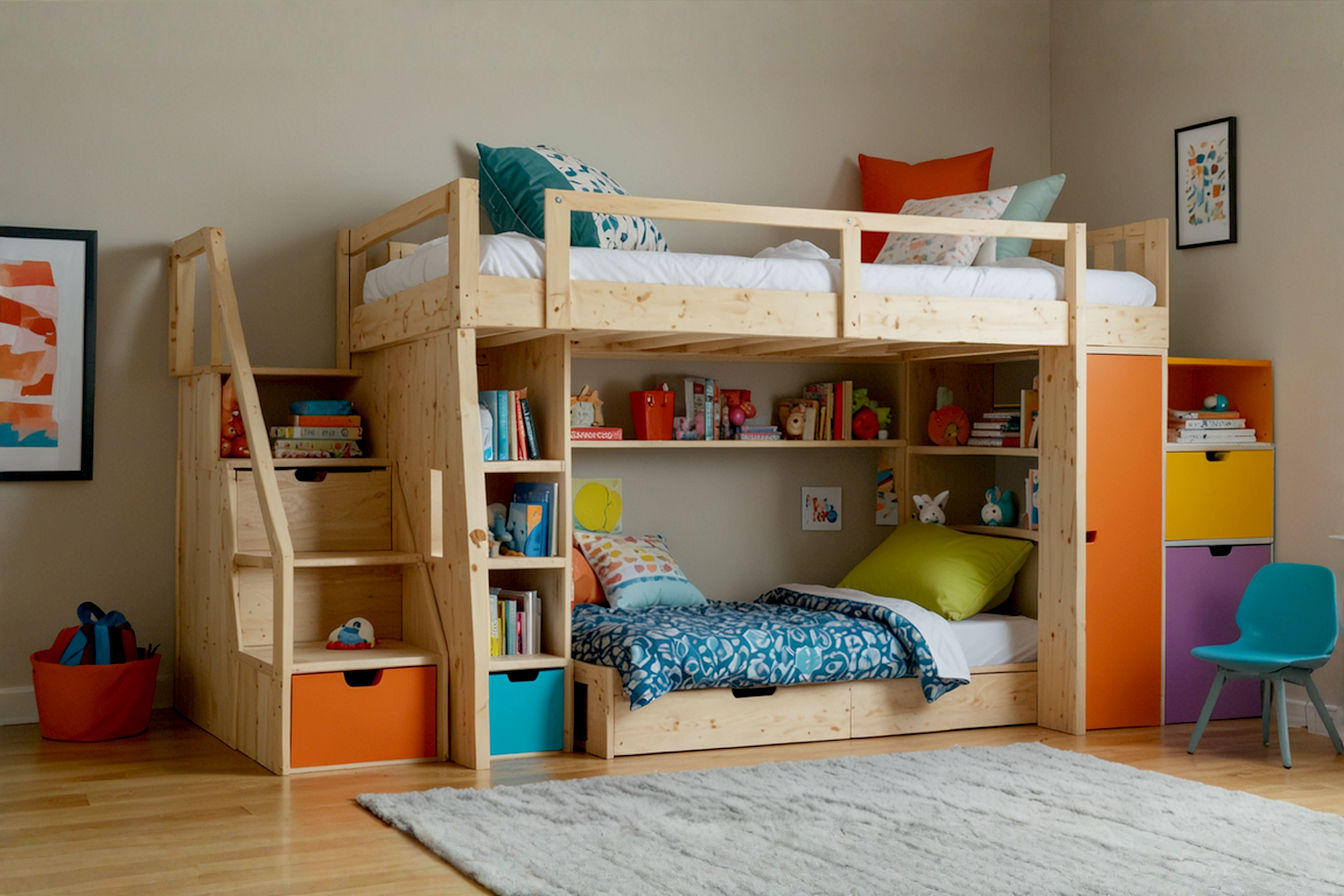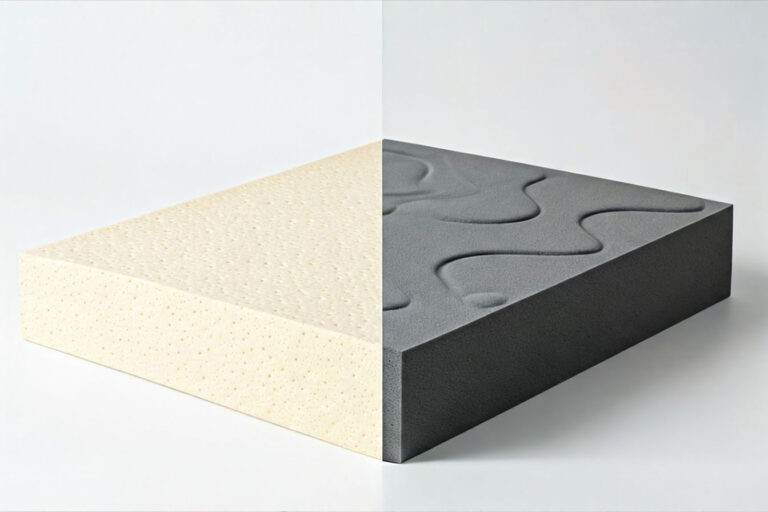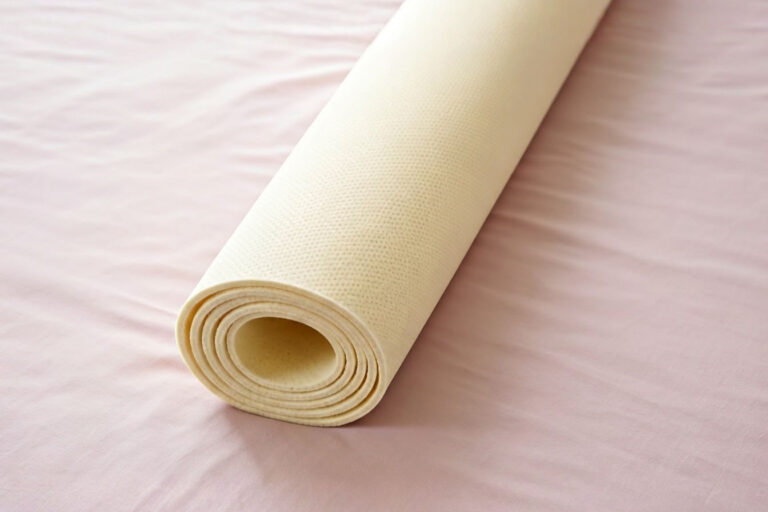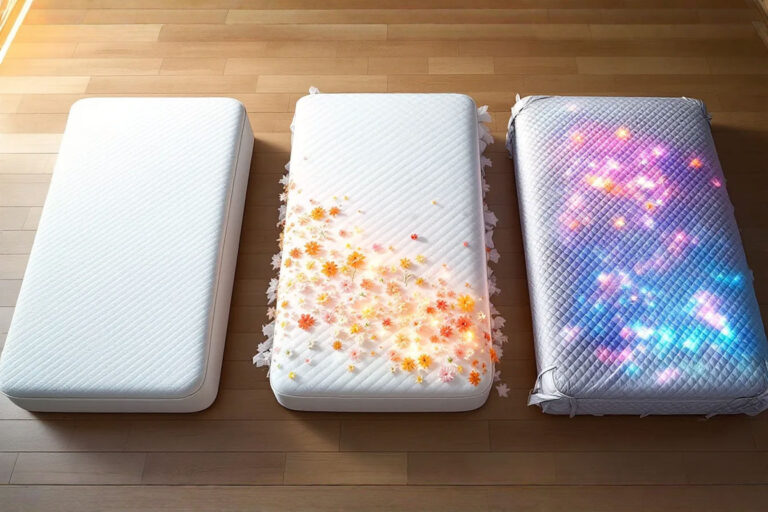Loft Bed Storage: The Complete System That Organizes a Child’s Room in Under 50 Square Feet
Discover how loft bed storage systems double usable space in children’s bedrooms, creating organized environments that support development while eliminating clutter—even in rooms under 50 square feet.

In the puzzle of modern living, few challenges prove as persistent as organizing a child’s bedroom in limited space. Parents everywhere face the dilemma of accommodating growing toy collections, books, clothes, and study materials within increasingly smaller bedrooms. The solution lies not in expanding walls, but in maximizing vertical space through thoughtfully designed loft bed storage systems.
These elevated sleeping quarters transform cramped quarters into functional havens, utilizing the often-neglected upper zone of the room while freeing valuable floor space below. A well-designed loft system doesn’t merely solve storage problems—it creates an organized environment that supports your child’s development, independence, and creativity within surprisingly modest square footage.
Understanding the Space Challenge
Today’s homes often feature children’s bedrooms averaging between 80-120 square feet, with urban apartments sometimes offering even less. This spatial constraint becomes particularly challenging when traditional furniture arrangements consume most available floor area, leaving children with minimal play space and creating constant clutter issues.
The typical bed alone consumes 15-20 square feet of precious floor real estate. When combined with essential storage furniture like dressers and bookcases, over half the room disappears before accommodating any toys or activity areas. This spatial deficit leads to perpetual organization struggles, with belongings spilling into other home areas and creating daily frustration.
Beyond practical considerations, organized environments significantly impact childhood development. Research consistently shows that children thrive in spaces where they can easily find, use, and return their belongings. Well-organized rooms promote independence, reduce anxiety, and support better focus during play and study activities. The loft bed storage approach directly addresses these developmental needs while solving spatial limitations.
What Makes Loft Beds the Ultimate Space Solution
The genius of loft bed systems stems from their vertical utilization principle. By elevating the sleeping surface, these designs immediately reclaim the largest single-use floor space in the room, transforming it into a multi-functional zone. This approach can effectively double the usable area in a small bedroom without changing its dimensions.
Traditional bedroom layouts place all furniture along the perimeter, creating a centralized “empty” space that often serves limited purpose. Loft systems invert this approach, utilizing vertical volume while creating defined zones below for study, play, storage, or seating. This reconfiguration makes efficient use of every cubic inch, rather than just square footage.
The multi-functional nature of these systems also addresses the diverse needs of growing children. Unlike single-purpose furniture that serves limited functions, a comprehensive loft system adapts to various activities throughout the day. The same compact footprint can accommodate sleeping, studying, playing, and organized storage—an impossible feat with traditional furniture arrangements in tight spaces.
Types of Loft Bed Storage Systems
Several loft bed configurations exist, each offering distinct advantages depending on room dimensions, child age, and specific needs. Full-height loft designs typically position the sleeping surface 5-6 feet above the floor, creating maximum space beneath for desks, dressers, or complete play areas. These systems work exceptionally well in rooms with standard 8-foot ceilings and for older children who can safely navigate ladders or stairs.
Mid-height options, raising the bed approximately 3-4 feet, strike a balance between space creation and accessibility. These designs prove ideal for younger children or rooms with lower ceilings. The underneath area still accommodates considerable storage through drawers, shelves, or specially designed play zones while remaining accessible to smaller children.
Storage-integrated frames incorporate drawers, shelves, and compartments directly into the bed structure itself. These systems maximize organization potential through cleverly designed steps doubling as drawers, headboards with built-in shelving, or railings incorporating hanging storage. For ultimate customization, many parents opt for custom-built solutions tailored precisely to room dimensions and specific needs, though quality prefabricated options offer excellent functionality at lower price points.
Core Components of a Complete Loft Bed Storage System
A truly effective loft storage solution extends beyond merely elevating the bed. The comprehensive system includes several integrated elements working together to maximize organization. The foundation begins with a sturdy bed frame structure designed specifically for elevated positioning, incorporating proper safety features like secure railings and stable access methods.
The under-bed organization zone forms the heart of the system, typically divided into distinct functional areas. This space might include a dedicated study desk, dresser storage, open shelving for frequently accessed items, or a defined play area with toy storage. The most effective designs create visual separation between these zones while maintaining a cohesive overall look.
Wall-mounted complementary storage extends the system vertically, utilizing wall space adjacent to and surrounding the loft bed. These elements might include floating shelves, pegboard systems, wall pockets, or mounted bookcases. Finally, multi-functional furniture elements complete the approach—ottomans with hidden storage, convertible desks, fold-down tables, or nesting furniture that adapts to changing needs throughout the day and as the child grows.
Designing the Perfect Loft Storage System
Creating an effective loft bed storage solution begins with thoroughly assessing your child’s specific needs. Consider their daily activities, favorite toys, books, collections, and study requirements. Take inventory of everything requiring storage, grouping items by frequency of use, size, and natural categories. This assessment forms the foundation of your storage planning.
Accurate space measurement proves critical for successful implementation. Beyond recording room dimensions, note ceiling height, window and door positions, electrical outlets, light switches, and any architectural features requiring accommodation. Create a scaled drawing or use online room planning tools to visualize potential layouts before making purchasing decisions.
Age considerations dramatically impact design choices. For younger children (ages 3-5), prioritize accessibility with lower loft heights, simpler access methods, and storage within easy reach. Elementary-aged children (6-9) benefit from defined activity zones and beginning study spaces. Pre-teens and teenagers require more sophisticated study areas, personalization options, and storage for evolving interests and school demands.
Perhaps most importantly, consider growth adaptability factors in your design. The ideal system evolves as your child develops, with components that can be reconfigured, repurposed, or expanded. Modular systems offering additional compatible pieces provide excellent long-term value compared to age-specific furniture quickly outgrown.
Under-Bed Storage Solutions
The reclaimed space beneath a loft bed offers remarkable organization potential through various storage approaches. Open shelving systems provide easily accessible storage for frequently used items while maintaining visual openness that prevents the space from feeling cramped. These shelves work particularly well for displaying books, bins of categorized toys, or collections.
Drawer systems and roll-out bins offer more concealed storage perfect for clothing, seasonal items, or less frequently accessed belongings. Many specialized loft systems include integrated drawer units designed to fit precisely beneath the bed frame. Alternatively, standard dressers or storage cubes can be positioned in this space in compatible dimensions.
Creating designated zones for different activities maximizes functionality in the under-bed area. Clear visual and physical separation between study, play, and storage areas helps children mentally transition between activities and maintains organization. This might involve using different furniture pieces, area rugs, or even fabric panels to create semi-private nooks within the larger space.
For school-aged children and teens, incorporating a desk or study area beneath the loft becomes invaluable. This dedicated workspace typically includes a work surface, task lighting, and surrounding storage for school supplies and reference materials. The partially enclosed nature of this space beneath the loft naturally minimizes distractions while studying—a significant advantage over traditional room arrangements.
Wall-Mounted Storage to Complement the Loft System
While the loft bed itself dramatically increases floor space utility, wall-mounted storage elements complete the system by maximizing vertical surfaces. Floating shelves offer flexible storage without consuming floor space, working particularly well adjacent to loft beds or in previously unusable corner areas. Installing these shelves at various heights creates visual interest while accommodating different storage needs.
Pegboard systems provide unmatched flexibility for frequently changing storage requirements. These perforated panels accept various hooks, shelves, and containers that can be endlessly reconfigured as needs evolve. Modern pegboard options include attractive colors and materials that contribute positively to room aesthetics while offering practical storage.
Fabric wall pockets and hanging organizers utilize soft, lightweight materials to create vertical storage perfect for smaller items like art supplies, small toys, or accessories. These options add textural interest to the room while keeping frequently used items visible and accessible. For display and communication needs, magnetic and cork surfaces mounted near the study area facilitate homework reminders, artwork display, and personalization options that don’t consume valuable storage space.
Maximizing Every Inch: Hidden Storage Opportunities
Truly comprehensive loft systems incorporate storage into every possible component, including access methods. Stair storage transforms necessary loft access into valuable organization space through drawers built into each step or pull-out compartments beneath the staircase. This approach proves particularly effective for items requiring regular access like shoes, everyday toys, or books.
Headboard integrated storage creates convenient access to bedtime essentials without consuming additional space. These designs typically incorporate shelving or small compartments directly into the bed structure itself, perfect for books, electronic devices, small toys, or display items. Some advanced systems even include adjustable reading lights, charging stations, or small fold-down surfaces within the headboard unit.
The furniture chosen for underneath the loft offers additional hidden storage opportunities. Consider ottomans with removable tops concealing interior storage, window seats with hinged lids, or benches with drawer storage beneath. Even seating can incorporate storage through chairs with under-seat compartments or fold-down desks with interior organization.
For rooms with sufficient ceiling height, consider ceiling-mounted options like hanging organizers, suspended shelving, or decorative netting for lightweight toy storage. These unexpected storage locations capture otherwise unused space while adding visual interest to the room design. Even curtain rods around the loft bed perimeter can double as hanging storage for lightweight items when fitted with appropriate hooks or rings.
Organization Strategies for Different Age Groups
Effective loft bed storage systems adapt to children’s changing developmental stages and needs. For toddlers and young children (ages 3-5), prioritize accessibility and simplicity with color-coded storage systems and picture labels on containers. Lower loft heights with simple access methods ensure safety, while open storage bins facilitate easy clean-up. These younger children benefit from rotation systems for toys, with only a portion available at once to prevent overwhelming clutter.
Elementary-aged children (6-9) develop increased independence in organization when provided appropriate systems. This age group benefits from clearly defined storage categories, written labels they can read themselves, and beginning responsibility for maintaining their own spaces. Homework areas become increasingly important, though play space still requires significant accommodation.
Pre-teens and teenagers require more sophisticated organization addressing school demands, evolving interests, and social needs. Their loft systems often feature more extensive desk areas, technology accommodation, and personal expression zones. Storage shifts toward supporting academic materials, hobby supplies, and collections rather than traditional toys. Privacy also becomes increasingly important, with the loft bed sometimes incorporating curtains or partial visual barriers.
Regardless of age, the most successful systems incorporate adaptive flexibility that grows with the child. Modular components, adjustable shelving, and reconfigurable elements ensure the investment continues providing value through multiple developmental stages. Look for systems allowing component additions or modifications rather than requiring complete replacement as needs change.
Material and Safety Considerations
Safety forms the foundation of any children’s furniture system, particularly for elevated sleeping arrangements. Sturdy construction materials capable of supporting significant weight prove essential—solid wood construction generally offers superior durability compared to particleboard alternatives, though quality engineered wood products provide excellent performance at lower price points.
Safety railings must extend at least 5 inches above the mattress surface on all exposed sides of loft beds, with gaps between rails narrow enough to prevent entrapment (less than 3.5 inches). Access considerations include stable, permanently attached ladders or stairs with appropriate handrails and non-slip surfaces. For younger children, consider stairs rather than ladders for easier navigation.
Weight limits require careful attention, with most commercial loft systems rated between 200-250 pounds. This capacity must accommodate both the child and any friends who might join them, with additional safety margins. The support structure beneath loft beds demands particular scrutiny, ensuring proper engineering for lateral stability and weight distribution.
All children’s furniture should feature non-toxic finishes free from harmful chemicals. Look for products certified by recognized safety organizations and those using child-safe paints, stains, and sealants. Water-based finishes typically release fewer potentially harmful volatile organic compounds (VOCs) compared to traditional solvent-based alternatives, making them preferable for children’s spaces.
Installation Tips and Considerations
The decision between DIY installation and professional assembly depends on your skills, available tools, and the complexity of your chosen system. While many prefabricated loft beds include comprehensive instructions for home assembly, custom-built or more elaborate systems often benefit from professional installation ensuring structural integrity and safety.
For DIY installation, expect to need basic carpentry tools including drills, wrenches, levels, and measuring equipment. More importantly, the process requires careful attention to detail, precise measurement, and usually assistance from a second person for handling larger components. Most installations take between 4-8 hours depending on complexity and experience level.
Common installation challenges include ensuring proper wall attachment for stability, managing uneven floors or walls, and coordinating electrical outlet access with furniture placement. Address floor leveling issues before beginning assembly, using appropriate shims or leveling techniques to create a stable foundation. For wall-mounted components, always locate and utilize wall studs rather than relying solely on drywall anchors for support.
After assembly, thorough safety testing becomes essential before allowing children to use the system. Test all weight-bearing elements with adult weight, check for any wobbling or instability, examine all fasteners for proper tightening, and verify smooth operation of any moving parts like drawers or fold-down components. Periodically repeat these safety checks throughout the life of the furniture to identify any developing issues.
Real-World Examples: Success Stories
The transformative potential of loft bed storage systems becomes evident through real-world implementations. Consider the case of the Johnson family, whose 8-year-old daughter occupied a 9×10-foot bedroom (90 square feet) overrun with toys, books, and clothing. Their traditional furniture arrangement left virtually no floor space for play or activities.
After installing a full-height loft bed with integrated stair storage, a dedicated desk area, and wall-mounted shelving, the same room accommodated all previous belongings while reclaiming over 70% of the floor space. The newly organized environment not only looked dramatically different but fundamentally changed how their daughter interacted with her possessions. Previously lost items became consistently findable, homework completion improved with a dedicated study space, and bedtime routines simplified with intuitive organization.
Parent testimonials consistently highlight unexpected benefits beyond mere storage improvement. Many report increased independence in children maintaining their own spaces, reduced conflicts over cleaning responsibilities, and fewer belongings migrating to other household areas. The psychological benefits of these systems extend beyond organization, with children often developing greater ownership and pride in their personal spaces after such transformations.
Budget-Friendly Approaches
While custom-built loft systems can represent significant investments, numerous affordable approaches make this solution accessible across various budgets. Many furniture retailers offer complete loft bed systems at entry-level price points between $300-800, typically including the elevated bed frame and some basic under-bed storage or desk components. These mass-produced options provide excellent value for standard room dimensions.
For those with woodworking skills, DIY modifications to existing furniture often create custom solutions at minimal cost. Standard bed frames can be elevated using bed risers or custom platforms, creating under-bed storage without purchasing entirely new furniture. Similarly, repurposing bookcases, desks, or storage cubes beneath an elevated bed creates custom configurations at fraction of prefabricated system costs.
Phased implementation offers another budget-conscious approach, beginning with the essential loft bed structure and adding complementary storage elements over time as budget allows. This strategy spreads investment while immediately delivering the primary space-saving benefits. Focus initial purchases on high-impact components addressing your most pressing storage needs, then expand systematically.
When evaluating costs, consider long-term value rather than merely initial investment. Quality systems designed to adapt through childhood stages ultimately deliver greater value than disposable furniture requiring frequent replacement. Factor potential increases in home value for built-in systems, cost savings from avoiding room expansions, and the practical value of reduced clutter throughout the home when calculating true return on investment.
Maintenance and Adaptation Over Time
Maintaining loft bed systems requires consideration of both cleaning accessibility and structural integrity. Design your system with cleaning practicality in mind—ensure vacuum access beneath components, choose easy-clean surfaces for frequently touched areas, and consider dust accumulation on elevated surfaces. Regular inspection and tightening of all fasteners, particularly those on weight-bearing components, ensures continued safety and stability.
As children grow, successful systems evolve through thoughtful modification. This might involve adjusting shelf heights, reconfiguring storage categories, or transitioning from toy storage toward academic material organization. For younger children, the under-bed area might initially feature play spaces later converted to study zones as academic demands increase.
The most adaptable systems incorporate modular components allowing reconfiguration without complete replacement. Look for furniture lines offering compatible pieces purchasable individually over time, allowing expansion or modification of the original system. Some manufacturers specifically design evolutionary furniture systems growing from toddlerhood through teenage years through strategic component substitution.
Long-term durability factors significantly impact satisfaction with these systems. Quality construction materials, proper installation, and regular maintenance contribute to longevity. Consider potential weak points in any system—drawer slides, hinges, ladder attachments—and evaluate the quality of these components when making purchasing decisions. Investing in higher-quality materials for these high-stress elements often proves more economical than entire system replacement when failures occur.
Common Mistakes to Avoid
Several common pitfalls undermine the effectiveness of loft bed storage systems. Inappropriate age design choices rank among the most frequent—selecting access methods too challenging for younger children, creating storage requiring adult assistance for routine access, or failing to consider visibility issues for various age heights. Always design primarily for your child’s current abilities while building in reasonable growth accommodation.
Many parents overlook critical growth considerations, selecting systems perfect for current needs but inflexible for future development. Children’s storage needs evolve dramatically between early childhood and teenage years; systems should anticipate these changes rather than requiring complete replacement as interests and activities transform.
The temptation to prioritize aesthetics over functionality sometimes leads to visually stunning but practically challenging designs. While appearance matters, functionality must drive primary decision-making. Beautiful systems failing to address actual storage needs or creating unnecessary access complications ultimately generate frustration regardless of their visual appeal.
Perhaps most critically, compromising on material quality and construction standards creates both safety concerns and premature replacement requirements. Saving money initially on poorly constructed systems typically costs more long-term through repairs, replacements, and potential safety issues. Invest in quality for weight-bearing components and high-use elements even when working within budget constraints.
Conclusion
The transformative power of vertical storage through well-designed loft bed systems cannot be overstated for small children’s rooms. These solutions fundamentally reimagine spatial utilization, effectively doubling functional area within existing dimensions while creating organized environments supporting childhood development. Beyond merely containing possessions, these systems create defined activity zones, promote independence, and adapt to evolving needs through crucial growth years.
The long-term benefits extend beyond physical organization to impact daily family dynamics, reducing clutter-related stress, simplifying cleaning routines, and creating spaces where children genuinely thrive. When thoughtfully selected, properly installed, and periodically adapted, these systems represent investments delivering daily practical returns throughout childhood.
For parents contemplating this approach, begin with thorough needs assessment and precise space measurement, then explore options across various price points and customization levels. Whether choosing commercial systems, custom builds, or DIY adaptations, prioritize safety, growth adaptability, and organization suited to your child’s specific requirements. The resulting transformation will likely exceed expectations, creating efficient, engaging spaces within even the most modest square footage.






